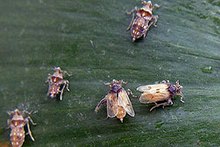Megamelus scutellaris
| Megamelus scutellaris | |
|---|---|

| |
| Scientific classification | |
| Domain: | Eukaryota |
| Kingdom: | Animalia |
| Phylum: | Arthropoda |
| Class: | Insecta |
| Order: | Hemiptera |
| Suborder: | Auchenorrhyncha |
| Infraorder: | Fulgoromorpha |
| Family: | Delphacidae |
| Genus: | Megamelus |
| Species: | M. scutellaris
|
| Binomial name | |
| Megamelus scutellaris Berg, 1883
| |
Megamelus scutellaris, the water hyacinth planthopper, is a true bug native to South America. It is used as a biological control agent to manage and reduce the spread of the water hyacinth (Pontederia crassipes, formerly Eichhornia crassipes), an invasive aquatic plant native to South America that has invaded many freshwater systems globally.
Description[edit]
Megamelus scutellaris has a widespread distribution in South America. Populations have been recorded in Argentina, Brazil, Peru and Uruguay, and it is likely that the insect mirrors much of the distribution of its host plant, water hyacinth.[1] It is primarily pale yellow to light brown in color with darker markings on the head and thorax. It measures approximately 3-4 mm in length, with a distinct, helmet-like scutellum covering most of its abdomen.[2]

The insect's life cycle consists of egg, nymph, and adult stages. They are wing dimorphic, whereby the adults can be either wingless (brachypterous) or winged (macropterous).
Biological control of water hyacinth[edit]
Megamelus scutellaris is host-specific to water hyacinth, and has been introduced as a herbivore agent for the biological control of the noxious weed, causing damage to the plants and inhibiting their growth and reproduction. It was first introduced to Florida in 2010, where it subsequently established.[3] It has been observed to thrive in cooler regions of the native water hyacinth range, which led to its introduction in 2013 to more temperate regions in South Africa as an effective biological control agent.[4]
Both adult and nymph M. scutellaris feed on the water hyacinth plants.[3] Adult females lay their eggs on the leaves and petioles of water hyacinth plants, and upon hatching, the nymphs feed on the plant tissues, progressing through five instar stages before reaching adulthood. This feeding results in biotic stress and increases the plant's susceptibility to disease.[5] Under extensive feeding pressure, the plants may eventually succumb, causing them to sink and consequently leading to a decline in the water hyacinth population.
References[edit]
- ^ Sosa, A. J.; Cordo, H. A.; Sacco, J. (2007-08-01). "Preliminary evaluation of Megamelus scutellaris Berg (Hemiptera: Delphacidae), a candidate for biological control of waterhyacinth". Biological Control. 42 (2): 129–138. doi:10.1016/j.biocontrol.2007.04.012. ISSN 1049-9644.
- ^ Sosa, A. J.; Marino De Remes Lenicov, A. M.; Mariani, R.; Cordo, H. A. (2004-03-01). "Redescription of Megamelus scutellaris Berg (Hemiptera: Delphacidae), a Candidate for Biological Control of Water Hyacinth". Annals of the Entomological Society of America. 97 (2): 271–275. doi:10.1603/0013-8746(2004)097[0271:ROMSBH]2.0.CO;2. S2CID 6527766.
- ^ a b Tipping, Philip W.; Sosa, Alejandro; Pokorny, Eileen N.; Foley, Jeremiah; Schmitz, Don C.; Lane, Jon S.; Rodgers, Leroy; Mccloud, Lori; Livingston-Way, Pam; Cole, Matthew S.; Nichols, Gary (June 2014). "Release and Establishment of Megamelus scutellaris (Hemiptera: Delphacidae) on Waterhyacinth in Florida". Florida Entomologist. 97 (2): 804–806. doi:10.1653/024.097.0264. ISSN 0015-4040.
- ^ Coetzee, Julie A.; Miller, Benjamin E.; Kinsler, David; Sebola, Keneilwe; Hill, Martin P. (2022-11-02). "It's a numbers game: inundative biological control of water hyacinth (Pontederia crassipes), using Megamelus scutellaris (Hemiptera: Delphacidae) yields success at a high elevation, hypertrophic reservoir in South Africa". Biocontrol Science and Technology. 32 (11): 1302–1311. doi:10.1080/09583157.2022.2109594. ISSN 0958-3157. S2CID 251485734.
- ^ Sutton, G. F.; Compton, S. G.; Coetzee, J. A. (2016-12-01). "Naturally occurring phytopathogens enhance biological control of water hyacinth (Eichhornia crassipes) by Megamelus scutellaris (Hemiptera: Delphacidae), even in eutrophic water". Biological Control. 103: 261–268. doi:10.1016/j.biocontrol.2016.10.003. ISSN 1049-9644.
